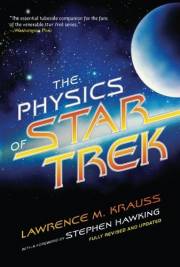 What warps when youÔÇÖre traveling at warp speed? What is the difference between a wormhole and a black hole? Are time loops really possible, and can I kill my grandmother before I am born? Anyone who has ever wondered ÔÇ£could this really happen?ÔÇØ will gain useful insights into the Star Trek universe (and, incidentally, the real world of physics) in this charming and accessible guide. Lawrence M. Krauss boldly goes where Star Trek has gone-and beyond. From Newton to Hawking, from Einstein to Feynman, from Kirk to Picard, Krauss leads readers on a voyage to the world of physics as we now know it and as it might one day be.
What warps when youÔÇÖre traveling at warp speed? What is the difference between a wormhole and a black hole? Are time loops really possible, and can I kill my grandmother before I am born? Anyone who has ever wondered ÔÇ£could this really happen?ÔÇØ will gain useful insights into the Star Trek universe (and, incidentally, the real world of physics) in this charming and accessible guide. Lawrence M. Krauss boldly goes where Star Trek has gone-and beyond. From Newton to Hawking, from Einstein to Feynman, from Kirk to Picard, Krauss leads readers on a voyage to the world of physics as we now know it and as it might one day be.
EDITORIAL REVIEWS
FROM PUBLISHERS WEEKLY
Even those who have never watched an episode of Star Trek will be entertained and enlightened by theoretical physicist Krauss’s adventurous investigation of interstellar flight, time travel, teleportation of objects and the possibility of extraterrestrial life. Case Western Reserve professor Krauss maintains that Star Trek’s writers were sometimes far ahead of scientists?and famed astrophysicist Stephen Hawking’s foreword, endorsing the possibilities of faster-than-light travel and journeying back in time, supports that notion. On the other hand, Krauss also argues that the show is riddled with bloopers and huge improbabilities, as when the Voyager’s crew escapes from a black hole’s interior. This informal manual for Trekkers offers a porthole on the wonders of the universe as it ponders the potential existence of aliens, “wormholes” that allow astronauts to tunnel through space, other dimensions and myriad baby universes. $75,000 ad/promo; BOMC and QPB alternates; Astronomy Book Club dual main selection; Library of Science, Natural Science Book Club and Newbridge Computer Book Club alternates.
Copyright 1995 Reed Business Information, Inc.
